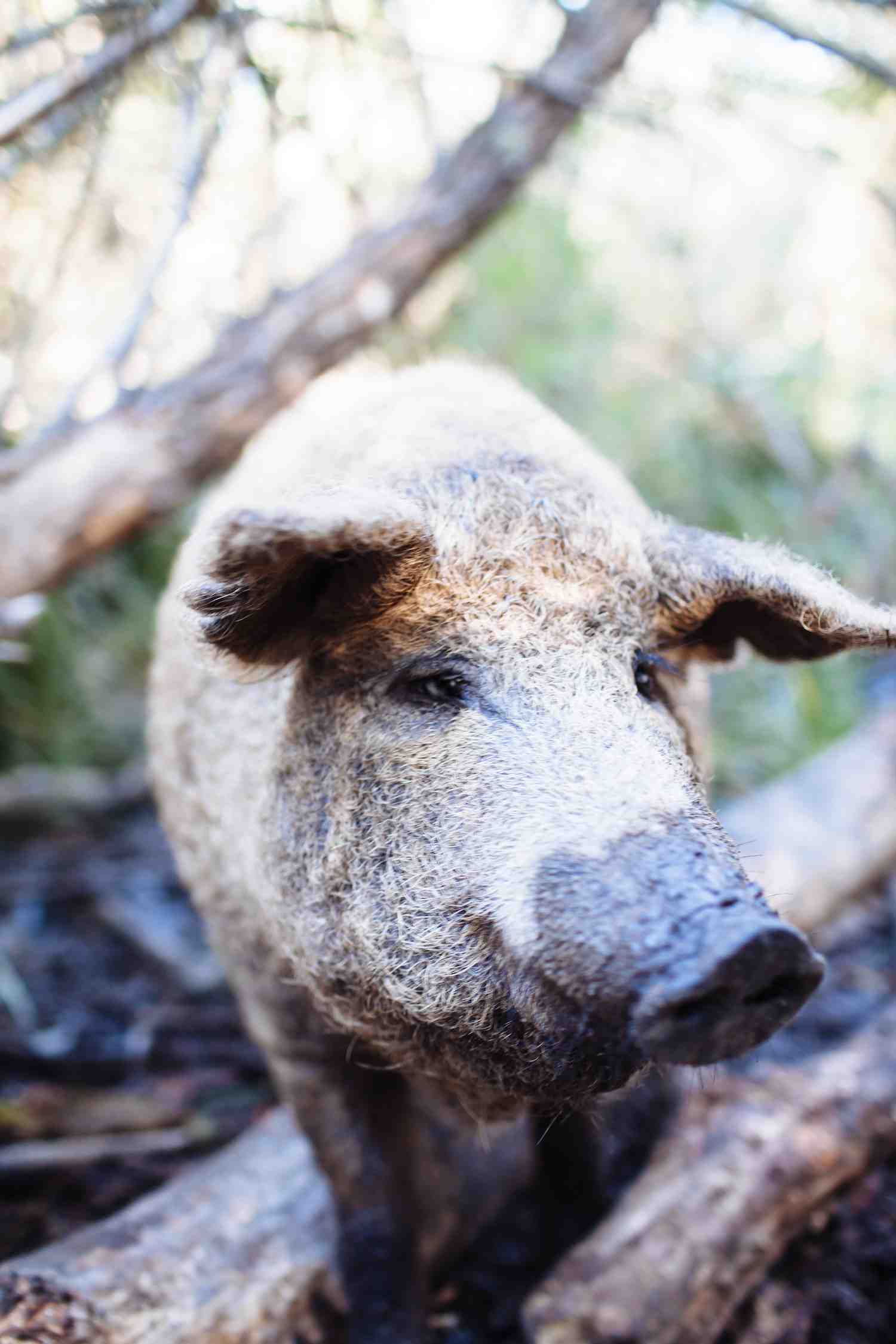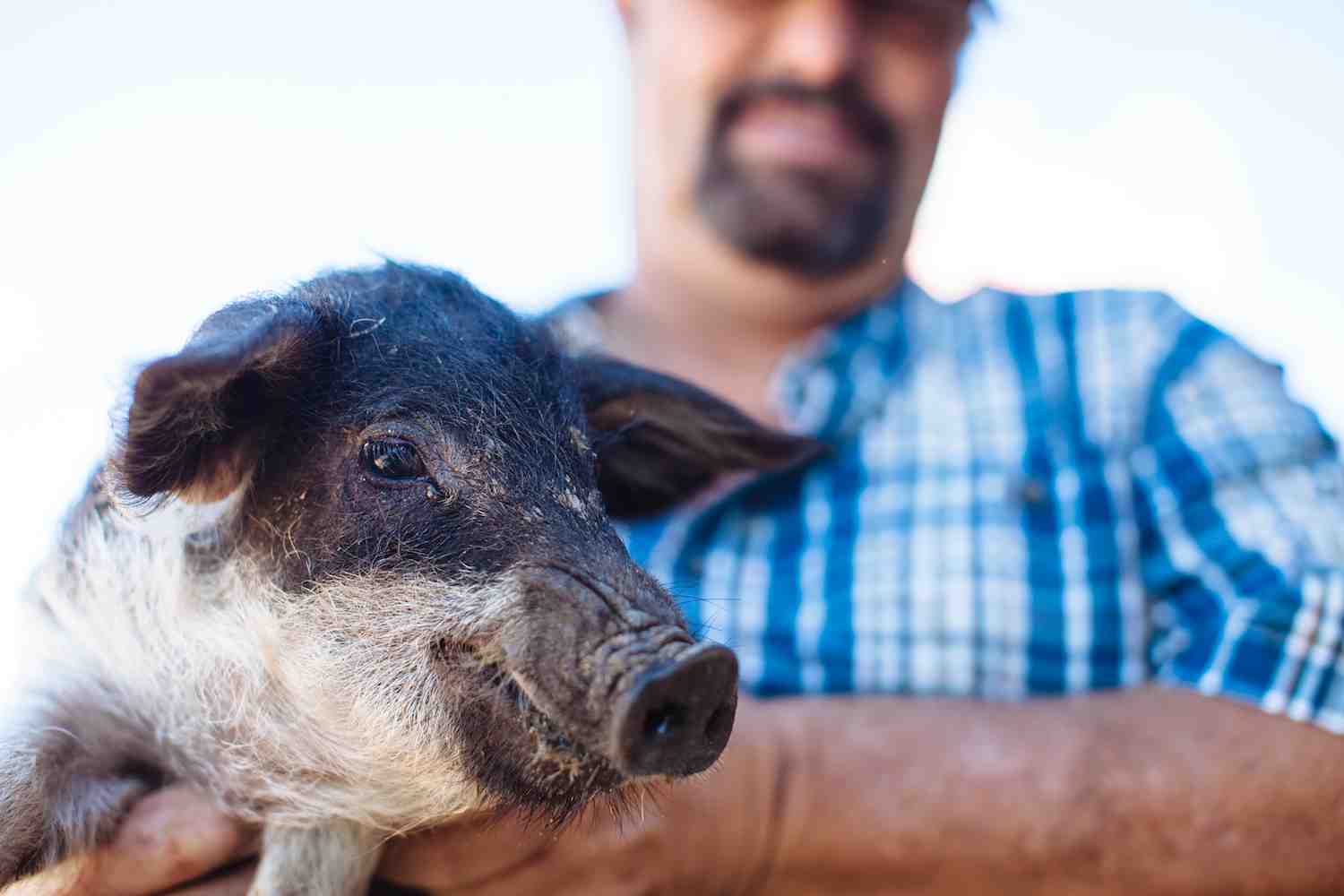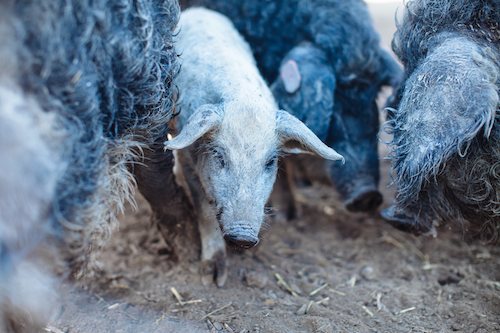European heritage pigs flourish in Sonoma County, but can we afford the luxury of real meat?
It’s a drizzly September morning, and I’m slogging through the lush junglelands of outer Forestville. Navigating riparian thicket, leafy overgrowth, and the periodic low-hanging tree branch, I also occasionally notice electric wire threaded near my ersatz hiking path. Just as I’m wondering to myself what parallel universe I’ve entered, Tim Winkler, my guide for the day, answers the question.
“It’s like walking through Vietnam, isn’t it?” he chuckles.
We are here to find pigs. In particular, Mangalitsa pigs—a wooly variety first brought from Hungary to the United States in 2007 and raised in Sonoma County, by Winkler alone, since 2009. Five minutes into our trek, the Mangalitsas are not at their feeder. Eight minutes in, they are not in a clearing. But after 10 minutes, I notice the faint glistening from a swampy bog of water through the bramble. There are muttered snout-noises—not oinks or squeals but something much lower—and then the stomping sounds of 18 hogs coming our way.
I crouch down as one would to a cat, and a particularly robust, sheeplike sow with a coat of wool waddles right up—smelling my hands, rooting its nose upon my clothes. “She’s real sweet, like a little Brillo pad,” Winkler says. “They’re very docile. They’re super pet-like.”
Bully Wooly
They’re also an old-world holdover, one that becomes more precious considering the furious pace of consolidation in the pork industry. As of 2008, just four companies—Smithfield, Tyson, Swift & Co., and Cargill—produced over 70 percent of the pork in the United States, along with all the environmental pollution, labor issues, inhumane housing, and questionable political influence that such consolidation brings.
In raising Mangalitsas here in Sonoma County, the same way they were raised for centuries in Europe, Winkler—along with a few other rare-breed pig farmers—keeps a sustainable, simple tradition alive.
Winkler isn’t kidding about the pigs’ friendly disposition. In 19th century Hungary, Mangalitsas would behave almost like the family dog, often following the farm children to school. Theirs was a meat prized for its fatty taste and useful lard, exported to countries around Europe as any other breed.
This is actually what it costs to produce it in a healthy way. Johnny Wilson
But after the early 20th century, when a push was made for leaner pork grown quickly, and when lard began to fall out of fashion in favor of Crisco and other vegetable oils, the Mangalitsa population steadily dwindled. After the collapse of communism, a Hungarian animal geneticist named Peter Toth decided to roam the country in 1991 to save what remained of the breed. He found 198 animals.
In the U.S. that year, “Pork: The Other White Meat” was still the official slogan of the National Pork Board. There was virtually no market for fatty, meaty pig. Yet, enough people remembered the marbled, buttery-fat taste of real pork. Toth regenerated the breed, his business grew, and eventually Mangalitsas made their way to the U.S. courtesy of Heath Putnam, a Washington farmer who brought 25 of them stateside. Putnam sold his operation to Mosefund, a New Jersey farm, in 2012, but not before shipping a handful to Sonoma County.
Winkler, born and raised in Santa Rosa, wasn’t initially interested in the pigs’ meat. The truck he drives today still bears the company name Winkler Aquascapes; for decades, Winkler installed aquariums and backyard koi ponds before eventually moving up to service large-scale estate ponds. Some of his customers were having problems with invasive weeds, and “if you’re not using chemicals,” Winkler says of weed eradication, “you have to use either manpower or equipment, and both of those, especially equipment, can leave a large carbon footprint.”
Wanting to avoid wasteful environmental impact, Winkler looked for some other way to rid the ponds of weeds, discovering that Mangalitsas love gobbling such predatory vegetation. He also found that they’d just been made available in the U.S. and that a buzz had started about the quality of their meat: flavorful and beef-like, sought after by foodies.
As he researched further, he learned about things like protein profiles and realized that feeding his pigs throwaway complex carbohydrates like the tortillas, donuts, or sour milk fed by more conventional farmers led to poor results. Last year, Winkler came full circle when he traveled to Michigan to meet with Peter Toth, the geneticist who originally helped save the breed in Hungary. “We’re now the second largest herd in the United States, next to Mosefund [in New Jersey],” Winkler says. “We have over 400 Mangalitsas, and we’re using 20 breeder boars from all five of the select different lines.”
Word soon got out that Winkler, 52, had the breed in Sonoma County, and now, he sells the meat all over the Bay Area and beyond. Restaurants like the French Laundry and Meadowood are regular customers, as are numerous eateries in San Francisco. Knowing chefs’ insistence on proper pH profiles, Winkler is more focused than ever on nutrition for top quality. “If the charcuterist does his part, and the farmer does his part, when that product comes back, it’s second-to-none,” he says proudly. “It’s very special. And that’s what the Spaniards and the Italians have done for centuries.”
One Las Vegas client buys only the lard. “The Mangalitsa breed actually was the number one commodity on the Viennese stock exchange during WWII, during the lard era, before refrigeration,” Winkler says. “They rubbed lard on their hands, put it on their door hinges, on their wagon wheels, they used it for everything.”
But with few of us now greasing our hinges with lard, it’s not easy to raise the pigs at a profit. Commercial pigs are bred for about five months to a weight of 250 pounds, while Mangalitsas need 12 to 18 months to reach full 350-pound maturity. Moreover, the meat needs to sell for twice as much, if not more, than factory-farmed pork.
But in addition to the flavorful taste and rich texture, Winkler’s operation offers something the mindful meat-eating consumer wants—an animal raised in a natural, humane environment. At Winkler’s 16-acre patch in Forestville, the pigs roam freely, rooting in the ground for acorns, tubers, willow bark, equisetum, monkey flower, insects, worms, roots, and duckweed. They drink from a natural bog of groundwater. This natural forest diet helps their meat, Winkler says. Though he supplements with a clean wheat mill run (no corn, soy, or alfalfa) to the tune of $2,200 a week, allowing the pigs to forage the land wherever their snouts may take them is the best course for quality. Getting that quality to pay off remains the trick.
Italian Forest Stock
Winkler isn’t the only Sonoma County pig producer raising rare European heritage breeds. Just outside of Cloverdale lies Acorn Ranch. Here, the pigs are a 700-year-old Cinta Senese breed, an animal from Italy’s Tuscany region that’s been around since the Middle Ages and is renowned for the quality of its muscle mass. An initiative of Front Porch Farms in Healdsburg, which also grows local grains, heritage vegetables, olive trees, and grapes, Acorn Ranch is home to the only purebred Cinta Senese pigs in the entire U.S.
Getting them here from Italy in 2012 wasn’t easy. Europeans fiercely protect their own foodstuffs. “It’s a regionally-protected product,” says Johnny Wilson, Front Porch’s farm manager. “They’re known for making some of the best prosciutto in the world. That’s really what the breed is optimized for. In getting the pig out to California, I’m sure they were a little bit worried about brand dilution.”
In addition to convincing Italian farmers to let go of just under 30 pigs, Front Porch faced issues with importation, quarantine, the USDA, and other obstacles. The result? Avid desire. Just as with the Mangalitsas, chefs started calling when word got out that Cintas were being raised locally.
Front Porch faces many of the same obstacles that Winkler must surmount in order to make the pigs profitable: longer maturation, higher costs, and public perception. “With the consolidation of the pork industry,” Wilson says, “people get used to paying a certain price for a certain product in the marketplace, whether it’s Safeway, Whole Foods, or the farmers’ market. And if you try to produce something in a sustainable way that’s ecologically responsible and takes care of the land, and you try to limit all of the detrimental effects and also pay people livable wages—all that stuff has a cost that goes into producing what we’re trying to do.”
Wilson continues. “The way the commercial hog industry operates, it sets the price bar really low, and the general consumer gets accustomed to paying for something that’s really cheap. And so when we absorb all the externalities that the commercial hog industry has other people pay for—whether it be through government subsidies, or whether it be in environmental costs they’re not accounting for—then it’s a challenge for us to educate consumers and differentiate our product, and say, ‘This is what you should be paying for this pork because this is actually what it costs to produce it in a healthy way.’”
Because Cintas take roughly two years to fully mature, the meat from Front Porch’s Cintas just recently hit the market. But it’s already been shipped to big prosciutto companies like La Quercia in Iowa and Olli Salumeria in Virginia as well as such restaurants as Spoonbar and Mateo’s Cucina Latina in Healdsburg; Diavola in Geyserville; Press in St. Helena; Zazu in Sebastopol; the French Laundry in Yountville; Oliveto in Oakland; and Cotogna and Quince in San Francisco.
If we get enough people underneath this, we'll be farming for a purpose. Tim Winkler
As for financial viability, Wilson will only cautiously say, “We’re getting there.”
It’s a quest echoed by Winkler, who is glad to break the economics down. “It’s not cheap,” Winkler says. “It costs us about 50 cents a pound to have a pig slaughtered, and then another dollar, thereabouts, to have a pig cut into pieces. So let’s say your animal is a 280-pound yield. Just off the bat, just slaughter and cutting into pieces, that gets up there, per animal. So when you hear about ‘normal’ pork, like Smithfield pork, selling for $1.91 a pound, and you’re into the damn thing for $1.40—and that’s not counting feed, time, gas, transport, anything—how, mathematically, does that work?”
The solution lies in educating the public and exposing the shortcuts and subsidies of Big Ag, Winkler insists. “We need people to know really what happens in the pork world,” he says, “and we need supporters of specialty pork. We have to have people believe in what we’re doing. Or else we’re gonna be spending more money than what it’s worth.”
Winkler looks out over the misty forest, to the pig herd that have since taken up giddy residence in a muddy bog of water.
“Right now we’re farming on a mission,” he says.
“If we get enough people underneath this, we’ll be farming for a purpose.”



